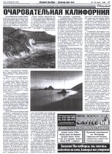Charming (fascinating) California (translated from Russian)
Vecherniy New York (New York Russian Newspaper)
August, 1999
Charming (fascinating) California
The Edward Carter Gallery, known for its exhibitions of landscape photography, is presenting the work of California Photographer Chip Hooper (pronounced “Cheap Khooper” with Russian accent). This is his debut in New York. The exhibition contains lyrical seascapes with fantastic (as in strange/unbelievable) cliffs, dunes, Anasazi ruins, views of Colorado Mountain plateaus and the mountain valleys of Yosemite.
Hooper lives on the Pacific Coast, in Carmel Valley, South of San Francisco. This area is a photographic Mecca. Ansel Adams, Edward Weston and Brett Weston lived and photographed here. Their beautiful landscapes remain unsurpassed to this day. One must possess an unusual creative audacity to travel the same paths as those great artists. As a child growing up near Lake Michigan, Hooper was hypnotized by the grandeur of the huge expanses of water and light. Though his interest in photography began in childhood, he became seriously involved only after moving in 1988 to the Pacific Coast. He was won over by his encounter with the Pacific Ocean, with the dry beauty and vast panoramas of the California coast.
Hooper divides his time between photography and the music business. He engages musical groups–mostly well-known rock and roll bands. His office is in Monterey, a city situated directly on the water. Hooper’s constant companions on his trips to work are a large format (8×10) camera, a tripod, and a pack of film holders, in the back seat of his car. On his way home from work, he observes the ocean views, and if he sees an unusually beautiful light, he calls his wife and says he’ll be an hour or two late.
This possibility to spend a lot of time observing the natural scene, apprehending its beauty, makes for Hooper’s extraordinary images. Going back to the same place many times increases the probability that he’ll be there art the right time, He explains: “I discovered that certain places can be really interesting at high tide, or at low tide, on a cloudy day–or at some other time. Certain conditions can make a wonderful photograph; therefore you can increase your chances by knowing a place. Those really special photographs–not the hundreds spread on the table which nobody every sees, but the ones we all remember–are those which resulted from an unhurried familiarity with a place.”
Chip Hooper, a professional businessman for whom photography is something of a hobby, has achieved in the filed a high level of professional mastery and recognition. Naturally, the question arises” How can these two time-demanding pursuits co-exist. HereÕs how Hooper explains the duality of his life: “I don’t do photography the way some people play golf or engage in other amusements. This isn’t something for which I can a lot time. I can’t plan for it because it’s a part of my life, like my family, my work–which are also part of my life. I have integrated photography into my life. I’m always looking for pictures. Always. Unconsciously.”
Continuing already established classical traditions of West Coast landscape photography, Hooper, responding on the spot to the unimaginable changes of light, sea and sky, has found his own vision of the natural scene. His landscapes have a characteristically meditative and solitary feeling. They emit a rich palette of light, which at once enraptures and calms.
The California coast is rich with sand dunes. They range from Los Angeles to Santa Barbara. This singularly place of wind-blown sands is rarely visited and remains relatively untouched since the time that Brett Weston was there. Both Edward Weston and Brett Weston were attracted by the sensitive rhythm and refined forms of the dunes. They expressed this beauty in the contrast of light and shadow. Hooper, in his search for natural abstract form, also turned his attention to the dunes. But his dune images lack contrast. Their form and texture are characterized by mid-tones –they are harmonious and refined. Dune photographs are one part of the artistic style of Chip Hooper.
Hooper is fascinated also by ancient Anasazi ruins and finds a kind of spiritual intimacy in his photographic work there. Here it is appropriate to say a few words about the Indian culture of the Anasazi, who lived during the X-XIII centuries in the southeast USA (Northern New Mexico and Arizona and south Utah and Colorado). The Anasazi Indians built their dwellings in the walls of mountain cliffs. In the XIII century, possibly because of increasing enemy attacks and a period of droughts, the Indians abandoned their cliff homes and moved south to join the plains tribespeople known as the Pueblo Indians. The dry climate and protected locations persevered many of the cliff dwellings. Archeologists have found ancient implements, bows, arrows, leather and cotton clothing, sandals, food and even mummified bodies. But let us return to the photographs. Hooper says of his work: “For me the process of creating photographs is contemplative. The best images happen when what I feel becomes one with what I see. These are the images which give the strong sensation of spirit, solitude and the past.”
Hooper believes that his photographs are a spiritual and aesthetic expression of the world he creates for himself and his family. Chip Hooper’s photographs invite the viewer to experience the world as the artist perceives it.
